Flame photometry
Flame photometry was originally established as a technique to detect trace concentrations of metallic ions in aqueous solutions and, following its application to aerosol studies, is adopted as part of the ISO standard EN149:2001+A1:2009 for testing of respiratory masks.
The sample aerosol is mixed with the fuel and passes through the photometer flame. Any metallic ions present in the sample will be excited by the flame, and emit light at an element-specific wavelength. Optical filters at the wavelength of interest are used to isolate the signal due to the researched element, and a photomultiplier (PMT) converts the filtered light into an electric signal. The voltage generated by the PMT is thus proportional to the mass concentration of the metallic ion of interest in the sample aerosol.
A reference PMT (capturing the total emission of the flame) is also present to monitor the flame and help identify any cross-sensitivities.
Flame photometry therefore combines high specificity with high sensitivity and a fast time response.
Need more information? Connect to an expert
